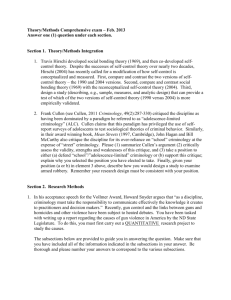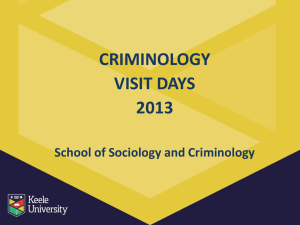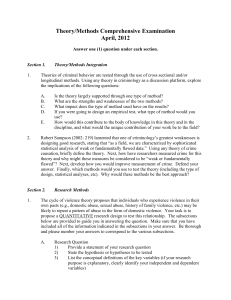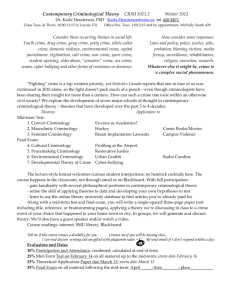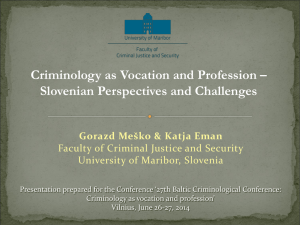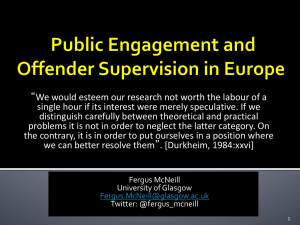DOC - Green Criminology
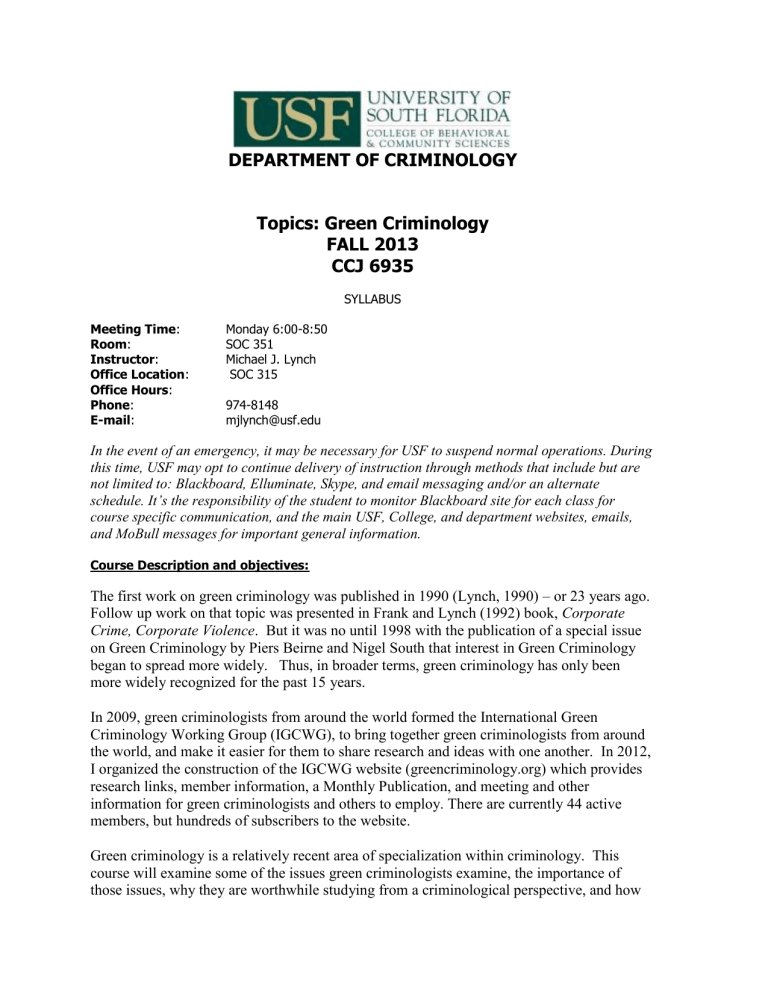
DEPARTMENT OF CRIMINOLOGY
Topics: Green Criminology
FALL 2013
CCJ 6935
Monday 6:00-8:50
SOC 351
Michael J. Lynch
SOC 315
974-8148 mjlynch@usf.edu
SYLLABUS
Meeting Time:
Room:
Instructor:
Office Location:
Office Hours:
Phone:
E-mail:
In the event of an emergency, it may be necessary for USF to suspend normal operations. During this time, USF may opt to continue delivery of instruction through methods that include but are not limited to: Blackboard, Elluminate, Skype, and email messaging and/or an alternate schedule. It’s the responsibility of the student to monitor Blackboard site for each class for course specific communication, and the main USF, College, and department websites, emails, and MoBull messages for important general information.
Course Description and objectives:
The first work on green criminology was published in 1990 (Lynch, 1990) – or 23 years ago.
Follow up work on that topic was presented in Frank and Lynch (1992) book, Corporate
Crime, Corporate Violence . But it was no until 1998 with the publication of a special issue on Green Criminology by Piers Beirne and Nigel South that interest in Green Criminology began to spread more widely. Thus, in broader terms, green criminology has only been more widely recognized for the past 15 years.
In 2009, green criminologists from around the world formed the International Green
Criminology Working Group (IGCWG), to bring together green criminologists from around the world, and make it easier for them to share research and ideas with one another. In 2012,
I organized the construction of the IGCWG website (greencriminology.org) which provides research links, member information, a Monthly Publication, and meeting and other information for green criminologists and others to employ. There are currently 44 active members, but hundreds of subscribers to the website.
Green criminology is a relatively recent area of specialization within criminology. This course will examine some of the issues green criminologists examine, the importance of those issues, why they are worthwhile studying from a criminological perspective, and how
they are studied. Some of the material we will read will not be written by criminologists – that is because some of the issues relevant to green criminology have a basis in other disciplines, and those works are worth reading to support the kind of work green criminologists do.
Student Learning Outcomes:
At the end of this course, students will be able to: define green criminology; identify major works in green criminology; understand the general and specific core areas of research in green criminology; identify core ideas and theories in green criminology; relate green criminology to relevant literature in other disciplines; discuss the need for green criminology; identify how green criminology differs from orthodox criminology.
Required Texts:
Kovel, Joel. (2007). The Enemy of Nature: The End of Capitalism or the End of the World?
NY: Zed Books.
Reece, Erik. (2006). Lost Mountain: A Year in the Vanishing Wilderness. Riverhead, NY:
Riverhead Books.
Additional Required Course Materials:
Additional required course materials are provided on the class website under
The INFORMATON tab. You should print these additional materials for inclusion in your notes for this course.
Class Expectations:
1. Attendance. Students are required to attend class.
2. Absences due to Religious Observances:
Students are expected to notify their instructors at the beginning of each academic term if they intend to be absent for a class or announced examination.
Students absent for religious reasons, as noticed to the instructor at the beginning of each academic term, will be given reasonable opportunities to make up any work missed. For further information, please refer to: http://generalcounsel.usf.edu/policies-and-procedures/pdfs/policy-10-045.pdf
3. Incompletes (I). May be granted after consultation with the instructor of this course
4. Extra Credit. There is no provision for extra credit.
5.
If you need to be absent due to medical reasons (yours or your immediate family's) on a test day or a day that an assignment is due, please provide a physician's note and notify me prior to class.
6.
Students will behave in a respectful manner.
7.
Students will complete all required assignments.
Course Requirements:
Exams: None.
Quizzes: None.
Group Discussions : Yes.
Assignments: Yes.
Your grade will be based on the following:
Assignment/Test
Midterm
Final
Group Discussion
Attendance
Homework
Paper/Written Assignments
Percent of Grade
0 %
0 %
30 %
10 %
0 %
60 %
The following is the grading scale to be used: This course employs a standard +/- grading scale:
A = 95-100 A- = 90-94 B+ = 87-89 B = 84-86 B- = 80-83 C+ = 77-79
C = 74-76 C - = 70-73 D = 60-69 F = below 60
TERM PAPER or Weekly Written Assignments
Students have the option in this course of: (1) writing a research term paper on any topic related to the materials in this course; or (2) of completing any 5 weekly written summaries for the assigned readings (all readings for a week count as one assignment).
Term papers . I set no limits on term papers, but expect that they are quality assignments worthy of a graduate course. This means that they investigate an area of theory or research, or carry out research. Original papers (e.g., those that carry out research, or propose a theoretical perspective) should be somewhere between 18-25 pages. Reviews of an area of relevant research should be 20-30 pages. All research projects should be interdisciplinary and draw on research from fields outside of criminology.
You should follow standard formatting for review and research papers. Make sure that you reference these papers adequately.
Term Papers are due November 13 th
.
Weekly Written Assignments. Weekly assignments do not need to review each article individually. Since weekly assignments include related materials, strong reviews relate the weekly materials to each other. A weekly review should be approximately 5 pages in length.
ATTENDANCE AND PARTICIPATION POLICIES
Attendance is required.
Attendance will be taken randomly. Your attendance score is constructed based on your attendance percentage.
The participation grade is based on the frequency and quality of your participation in class. Frequent but off track or irrelevant contributions do not count toward participation. Students who do not wish to participate in class discussion may earn participation points by posting comments, questions, and relevant news items with discussion on the class room discussion board.
COURSE SCHEDULE
The course schedule is attached to the end of this document.
CLASS POLICIES:
Students with Disabilities:
Students with disabilities are responsible for registering with Students with Disabilities
Services in order to receive academic accommodations. SDS encourages students to notify instructors of accommodation requests at least five business days prior to needing the accommodation. A letter from SDS must accompany this request.
See Student Responsibilities – http://www.sds.usf.edu/students.asp
See Faculty Responsibilities— http://www.sds.usf.edu/faculty.asp
Academic Dishonesty:
Any form of cheating on examinations or plagiarism on assigned papers constitutes unacceptable deceit and dishonesty. Disruption of the classroom or teaching environment is also unacceptable. The University of South Florida has very specific policies and procedures regarding academic dishonesty or disruption of academic process.
If you have any questions, please refer to the University’s Undergraduate Academic Dishonesty policy at
Procedures for Alleged Academic Dishonesty or Disruption: http://www.ugs.usf.edu/catalogs/0809/adadap.htm
Student Academic Grievance Procedures -- http://www.ugs.usf.edu/catalogs/0809/arcsagp.htm
Use of plagiarism tracking software:
The University of South Florida has an account with an automated plagiarism detection service which allows instructors to submit student assignments to be checked for plagiarism. I reserve the right to submit assignments to this detection system. Assignments are compared automatically with a huge database of journal articles, web articles, and previously submitted papers. The instructor receives a report showing exactly how a student's paper was plagiarized.
COURSE OUTLINE
With the exception of books and direct linked articles below, the articles listed below can be found on the class website under the “FILES” tab, and then by week. You may need to create a google account to download and use some of these files.
August
28 Introduction, Review of Syllabus and Course.
September
04 Green Criminology: Background and Theor y
Lynch, Michael J. 1990. The Greening of Criminology: A Perspective on the 1990s. The
Critical Criminologist 2,3: 3-4, 11-12.
South, Nigel. 1998. A Green Field for Criminology? A Proposal for a Perspective. Theoretical
Criminology 2, 2: 211-233.
Lynch, Michael J., and Paul B. Stretesky. 2011. “Similarities Between Green Criminology and
Green Science: Toward of Typology of Green Criminology.” International Journal of
Comparative and Applied Criminal Justice 35,4: 293-306.
Lynch, Michael J., and Paul B. Stretesky. 2003. “The Meaning of Green: Contrasting
Criminological Perspectives.” Theoretical Criminology. 7,2: 217-238.
Lynch, Michael J. and Paul B. Stretesky. 2001. “Toxic Crimes: Examining Corporate
Victimization of the General Public Employing Medical and Epidemiological Evidence.”
Critical Criminology. 10,3 153-172.
11 Green Criminology: Background and Theory, Con’t
Beirne, Piers. 1999. For a Nonspeciesist Criminology: Animal Abuse as an Object of Study.
Criminology 37,1: 117-147.
Lynch, Michael J., and Paul B. Stretesky. (2012). “Native Americans, Social and
Environmental Justice: Implications for Criminology.” Social Justice 38, 3: 34-54.
Long, Michael A., Paul B. Stretesky, Michael J. Lynch and Emily Fenwick. 2012. “Crime in the
Coal Industry: Implications for Green Criminology and Treadmill of Production Theory.”
Organization & Environment 25,3: 299-316.
Walters, Reece. 2010. Toxic Atmospheres Air Pollution, Trade and the Politics of Regulation.
Critical Criminology, 18,4: 307-323.
Walters, Reece. 2006. Crime, Bio-Agriculture and the Exploitation of Hunger. British Journal of Criminology, 46, 1: 26-45 .
18 Types of Green Crimes, Examples
N goc, Anh Cao and Tanya Wyatt. 2013. A Green Criminological Explanation of Illegal Wildlife
Trade in Vietnam. Asian Journal of Criminology 8: 129-142.
Wyatt, Tanya. 2013. From the Cardaman Mountain of Southwest Cambodia to the Forests of the World: An Exploration of Illegal Charcoal Trade. International Journal of Comparative and Applied Criminal Justice. 37, 1: 15-29.
Fitzgerald, Amy J., Linda Kalof, and Thomas Dietz. 2009. "Slaughterhouses and increased crime rates an empirical analysis of the spillover from “the jungle” into the surrounding community." Organization & Environment 22, 2: 158-184.
Pires, Stephen, and Ronald V. Clarke. 2012. "Are parrots CRAVED? An analysis of parrot poaching in Mexico." Journal of research in crime and delinquency 49, 1: 122-146.
25 Types of Green Crimes, Examples, Con’t
Lynch, Michael J., Ronald G. Burns and Paul B. Stretesky. 2010. “Global Warming as a State-
Corporate Crime: The Politicalization of Global Warming During the Bush Administration.”
Crime, Law and Social Change 54,3: 213-39.
Bisschop, Lieselot. 2012. "Is it all going to waste? Illegal transports of e-waste in a European trade hub." Crime, Law and Social Change 58, 3: 221-249.
Bisschop, Lieselot. 2012. "Out of the woods: the illegal trade in tropical timber and a
European trade hub." Global Crime 13, 3: 191-212.
Gibbs, Carole, Edmund F. McGarrell, Mark Axelrod, and Louie Rivers III. 2011. "Conservation criminology and the global trade in electronic waste: Applying a multi-disciplinary research framework." International Journal of Comparative and Applied Criminal Justice 35, 4: 269-
291.
Lemieux, Andrew M., and Ronald V. Clarke. 2009. "The international ban on ivory sales and its effects on elephant poaching in Africa." British Journal of Criminology 49, 4: 451-471.
OCTOBER
2 Compliance and Violation Research
Stretesky, Paul B., Michael A. Long and Michael J. Lynch. (2013) “Does environmental enforcement slow the treadmill of production? The relationship between large monetary penalties, ecological disorganization and toxic releases within offending corporations.”
Journal of Crime and Justice 36, 2: 235-249.
Stretesky, Paul B., and Michael J. Lynch. 2011. “Coal Strip Mining, Mountain Top Removal and the Distribution of Environmental Violations Across the United States, 2002-2008.”
Landscape Research 36,2: 209-230.
Stretesky, Paul B., and Michael J. Lynch. 2009. “Does Self-Policing Reduce Chemical
Emissions? A Further Test of the EPA Self Audit Policy.” The Social Science Journal 46,3:
459-473.
Lynch, Michael J., Paul B. Stretesky, and Ronald G. Burns. 2004. “Slippery Business: Race,
Class and Legal Determinants of Penalties Against Petroleum Refineries.” Journal of Black
Studies. 34,3: 421-440.
9 Ecological Marxism
Foster, John Bellamy, and Paul Burkett. (2008). Classical Marxism and the Second Law of
Thermodynamics: Marx/Engels, the Heat Death of the Universe Hypothesis, and the Origins of Ecological Economics. Organization & Environment 21, 1: 3-37.
Clausen, Rebecca, and Brett Clark. "The Metabolic Rift and Marine Ecology An Analysis of the Ocean Crisis Within Capitalist Production." Organization & Environment 18, no. 4
(2005): 422-444.
Clark, Brett, and Richard York. "Carbon metabolism: Global capitalism, climate change, and the biospheric rift." Theory and Society 34, no. 4 (2005): 391-428.
Foster, John Bellamy. "The Treadmill of Accumulation Schnaiberg’s Environment and
Marxian Political Economy." Organization & environment 18, no. 1 (2005): 7-18.
Burkett, Paul, and John Bellamy Foster. "Metabolism, energy, and entropy in Marx's critique of political economy: Beyond the Podolinsky myth." Theory and Society 35, no. 1 (2006):
109-156.
16
Ecological Marxism, Con’t
Clark, Brett, Andrew K. Jorgenson, and Daniel Auerbach. (2012). Up in Smoke The Human
Ecology and Political Economy of Coal Consumption. Organization & Environment 25, 4:
452-469.
Jorgenson, Andrew K., and Brett Clark. (2011). Societies Consuming Nature: A Panel Study of the Ecological Footprints of Nations, 1960–2003. Social Science Research 40, 1: 226-
244.
Jorgenson, Andrew K., and Brett Clark. "The economy, military, and ecologically unequal exchange relationships in comparative perspective: A panel study of the Ecological
Footprints of nations, 1975–2000." Social Problems 56, no. 4 (2009): 621-646.
Foster, John Bellamy. "Marx's Theory of Metabolic Rift: Classical Foundations for
Environmental Sociology 1." American Journal of Sociology 105, no. 2 (1999): 366-405.
Magdoff, Fred, and John Bellamy Foster. "What every environmentalist need to know about capitalism." Monthly Review 61, no. 10 (2010): 1-30. http://monthlyreview.org/2010/03/01/what-every-environmentalist-needs-to-know-aboutcapitalism
23 Environmental Justice
Stretesky, Paul B., and Michael J . Lynch. 1999. “Environmental Justice and the Prediction of Distance to Accidental Chemical Releases in Hillsborough County, Florida.” Social
Science Quarterly. 80,4:830-846.
Stretesky, Paul B., and Michael J. Lynch. 2002. “Environmental Hazards and School
Segregation in Hillsborough, 1987-1999.” The Sociological Quarterly. 43,4: 553-573.
Landrigan, Philip J., Clyde B. Schechter, Jeffrey M. Lipton, Marianne C. Fahs, and Joel
Schwartz. (2002). Environmental Pollutants and Disease in American Children: Estimates of
Morbidity, Mortality, and Costs for Lead Poisoning, Asthma, Cancer, and Developmental
Disabilities. Environmental Health Perspectives 110,7: 721-728.
Landrigan, Philip J., Virginia A. Rauh, and Maida P. Galvez. "Environmental justice and the health of children." Mount Sinai Journal of Medicine: A Journal of Translational and
Personalized Medicine 77, no. 2 (2010): 178-187.
Morello-Frosch, Rachel, Manuel Pastor, and James Sadd. "Integrating environmental justice and the precautionary principle in research and policy making: the case of ambient air toxics exposures and health risks among schoolchildren in Los Angeles." The annals of the
American academy of political and social science 584, no. 1 (2002): 47-68.
30 Environmental Justice, Con’t
Canfield, Richard L., Charles R. Henderson Jr, Deborah A. Cory-Slechta, Christopher Cox,
Todd A. Jusko, and Bruce P. Lanphear. "Intellectual impairment in children with blood lead concentrations below 10 μg per deciliter." New England Journal of Medicine 348, no. 16
(2003): 1517-1526.
Grandjean, Philippe, Pal Weihe, Roberta F. White, Frodi Debes, Shunichi Araki, Kazuhito
Yokoyama, Katsuyuki Murata, Nicolina Sørensen, Rasmus Dahl, and Poul J. Jørgensen.
"Cognitive deficit in 7-year-old children with prenatal exposure to methylmercury."
Neurotoxicology and teratology 19, no. 6 (1997): 417-428.
Evans, Gary W., and Lyscha A. Marcynyszyn. "Environmental justice, cumulative environmental risk, and health among low-and middle-income children in upstate New
York." American Journal of Public Health 94, no. 11 (2004). http://www.ncbi.nlm.nih.gov/pmc/articles/PMC1448566/
Pastor Jr, Manuel, James L. Sadd, and Rachel Morello ‐ Frosch. "Who's minding the kids?
Pollucion, public schools, and environmental justice in Los Angeles." Social Science
Quarterly 83, no. 1 (2002): 263-280.
Chakraborty, Jayajit, and Paul A. Zandbergen. "Children at risk: measuring racial/ethnic disparities in potential exposure to air pollution at school and home." Journal of epidemiology and community health 61, no. 12 (2007): 1074-1079.
November
6 BOOK
Kovel, Joel. (2007). The Enemy of Nature: The End of Capitalism or the End of the World?
NY: Zed Books.
13 BOOK
Reece, Erik. (2006). Lost Mountain: A Year in the Vanishing Wilderness. Riverhead, NY:
Riverhead Books.
20 OFF – ASC MEETINGS
27
DECEMBER
OFF – THANKSGIVING
4
BIBLIOGRAPHY OF RELATED MATERIALS (Things I considered but excluded due to time restrictions).
Agnew, Robert. 2012. Dire forecast: A theoretical model of the impact of climate change on crime. Theoretical Criminology, 16, 1: 21-42.
Beirne, Piers. 2011. "Animal abuse and criminology: introduction to a special issue." Crime,
Law and Social Change 55, 5: 349-357.
Beirne, Piers. 2009. Confronting animal abuse: Law, criminology, and human-animal relationships. Rowman & Littlefield Publishers.
Beirne, P., & South, N. (eds). (2007). Issues in green criminology: Confronting harms against environments, other animals, and humanity. Willan.
Beirne, Piers, and Nigel South, eds.2006. Green criminology. Ashgate.
Brisman, Avi. 2011. “Green Harms” as Art Crime, Art Criticism as Environmental Dissent.
Journal of Contemporary Criminal Justice, Vol. 27 Issue 4, p465-499
Bisschop, Lieselot. 2010. "Corporate environmental responsibility and criminology." Crime, law and social change 53, 4: 349-364.
Burns, Ronald G., and Michael J. Lynch.2002. Environmental crime. LFB Scholarly Pub.
Cazaux, Geertrui.1999. "Beauty and the beast: Animal abuse from a non-speciesist criminological perspective." Crime, Law and Social Change 31, 2: 105-125.
Colborn, Theo, Dianne Dumanoski and John Peterson Myers. (1996). Our Stolen Future.
NY: Plume.
Eliason, Stephen. 2012. "From the King's deer to a capitalist commodity: A social historical analysis of the poaching law." International Journal of Comparative and Applied Criminal
Justice 36, 2: 133-148.
Ellefsen, Rune, Ragnhild Sollund, and Guri Larsen. (eds). 2012. Eco-global Crimes:
Contemporary Problems and Future Challenges. Ashgate Publishing.
Eman, Katja; Meško, Gorazd; Dobovšek, Bojan; Sotlar, Andrej. 2013. Environmental crime and green criminology in South Eastern Europe: Practice and Research. Crime, Law & Social
Change, Vol. 59 Issue 3, p341-358.
Eman, Katja; and Gorazd Mesko. 2009. Green Criminology -- Attempt of Definition and
Discussion. . Varstvoslovje 11, 3: 357-381
Eman, Katja; Gorazd Mesko and Charles Fields. 2009. Crimes against the Environment:
Green Criminology and Research Challenges in Slovenia. Varstvoslovje 11, 4: 574-592.
Enticott, Gareth. 2011. "Techniques of neutralising wildlife crime in rural England and
Wales." Journal of Rural Studies 27, 2: 200-208.
Fitgerald, Amy J. 2010. The 'Underdog' as 'Ideal Victim'? The Attribution of Victimhood in the 2007 Pet Food Recall. International Review of Victimology 17, 2: 131-157.
Fitzgerald, Amy, and Lori B. Baralt. 2010. Media Constructions of Responsibility for the
Production and Mitigation of Environmental Harms: The Case of Mercury-Contaminated
Fish. Canadian Journal of Criminology and Criminal Justice 52, 4: 341-368.
Foster, John Bellamy, and Brett Clark. "Ecological imperialism: The curse of capitalism."
Socialist register (2003): 186-201.
Gibbs, Carole, Meredith L. Gore, Edmund McGarrell and Louie Rivers III. 2010. Introducing
Conservation Criminology. British Journal of Criminology, 50, 1: 124-144.
Green, Penny, Tony Ward, and Kirsten McConnachie.2007. "Logging and Legality:
Environmental Crime, Civil Society, and the State." Social Justice 34, 2: 94-110.
Groombridge, Nic. 1998. "Masculinities and crimes against the environment." Theoretical
Criminology 2, 2: 249-267.
Hallsworth, Simon.2011. "Then they came for the dogs!." Crime, law and social change 55,
5: 391-403.
Halsey, Mark. 2004. Against ‘Green’ Criminology. British Journal of Criminology, 44, 6:
833-853.
Hauck, Maria. "Crime, environment and power: revisiting the abalone fishery." S. Afr. J.
Crim. Just. 22 (2009): 229.
Hauck, Maria. 2008. "Rethinking small-scale fisheries compliance." Marine Policy 32, 4:
635-642.
Jarrell, Melissa L., and Joshua Ozymy. 2012. "Real crime, real victims: environmental crime
victims and the Crime Victims’ Rights Act (CVRA)." Crime, law and social change 58, 4:
373-389.
Jodoin, Sébastien, and Yolanda Saito. 2011. Crimes Against Future Generations: Harnessing the Potential of Individual Criminal Accountability for Global Sustainability. Université
McGill, Faculté de Droit.
Kalof, Linda, and Carl Taylor. 2007. "The discourse of dog fighting." Humanity & Society
31, 4: 319-333.
Katz, Rebecca S. 2012. "Environmental pollution: corporate crime and cancer mortality."
Contemporary Justice Review 15, 1: 97-125.
Katz, Rebecca S. 2010. "The corporate crimes of Dow chemical and the failure to regulate environmental pollution." Critical Criminology 18, 4: 295-306.
Kramer, Ronald C. "Carbon in the atmosphere and power in America: climate change as state-corporate crime." Journal of Crime and Justice ahead-of-print (2012): 1-18.
Lane, Pauline. 1998. "Ecofeminism meets criminology." Theoretical Criminology 2, 2: 235-
248.
Lewis, Bridget. 2012. "Human rights and environmental wrongs: achieving environmental justice through human rights law." International Journal for Crime and Justice 1, 1: 65-73.
Lynch, Michael J., and Paul B. Stretesky. 2013. The Distribution of Water-Monitoring
Organizations Across States: Implications for Community Policing. Policing: An
International Journal of Police Strategies and Management 36,1: 6-26.
Lynch, Michael J., Paul B. Stretesky and Paul Hammond. 2000. “Media Coverage of
Chemical Crimes: Hillsborough County, Florida, 1987-1997.” British Journal of
Criminology. 40,1:112-126.
Mares, Dennis. "Criminalizing ecological harm: Crimes against carrying capacity and the criminalization of eco-sinners." Critical Criminology 18, no. 4 (2010): 279-293.
Nurse, Angus. 2013. Animal Harm: Perspectives on why People Harm and Kill Animals.
Lund Humphries Publishers.
Oksanen, Markku. 2012. "Should trees have standing? Law, morality, and the environment."
Environmental Politics 21, 1: 174-175.
Pires, Stephen F., and Ronald V. Clarke. 2011. "Sequential foraging, itinerant fences and parrot poaching in Bolivia." British Journal of Criminology 51, 2: 314-335.
Rivers III, Louie, and Carole Gibbs. 2011. "Applying a conservation-criminology framework
to common-pool natural-resource issues." International Journal of Comparative and Applied
Criminal Justice 35, 4: 327-346.
Ruggiero, Vincenzo and Nigel South. 2010. Green Criminology and Dirty Collar Crime.
Critical Criminology 18, 4: 251-262.
Sollund, Ragnhild. 2011. "Expressions of speciesism: the effects of keeping companion animals on animal abuse, animal trafficking and species decline." Crime, law and social change 55, 5: 437-451.
South, Nigel, and Avi Brisman, eds. 2012. Routledge International Handbook of Green
Criminology. Routledge.
South, Nigel, and Tanya Wyatt. 2011. "Comparing illicit trades in wildlife and drugs: an exploratory study." Deviant Behavior 32, 6: 538-561.
Stretesky, Paul B., and Michael J. Lynch. 2001.”The Relationship Between Lead and
Homicide.” Archives of Pediatric and Adolescent Medicine. 155, 5:579- 582.
Stretesky, Paul B., and Michael J. Lynch. 2009. “A Cross-National Study of the Association
Between Per Capita Carbon Dioxide Emissions and Exports to the United States.” Social
Science Research. 38:239-250.
Stretesky, Paul, Sheila Huss and Michael J. Lynch. 2012. “Density Dependence and
Specialized Environmental Justice Organizations, 1970-2008.” The Social Science Journal
49,3: 343-51.
Stretesky, Paul B., Shelia Huss, Michael J. Lynch, Sammy Zahran and Bob Childs.
2011. “The Founding of Environmental Justice Organizations Across US Counties During the 1990s and 2000s: Civil Rights and Environmental Movement Cross Effects.” Social
Problems 58,3: 330-360. van Solinge, Tim Boekhout. 2010. "Deforestation crimes and conflicts in the Amazon."
Critical Criminology 18, 4: 263-277.
Walters, Reece. 2011. Eco crime and genetically modified food. Routledge.
Walters, Reece. 2007. "Food crime, regulation and the biotech harvest." European Journal of
Criminology 4, 2: 217-235.
Walters, Reece, and Diane Solomon Westerhuis. 2013. "Green crime and the role of environmental courts." Crime, Law and Social Change xx,x: : 1-12.
Wellsmith, Melanie. 2011. "Wildlife crime: The problems of enforcement." European
Journal on Criminal Policy and Research 17, 2: 125-148.
White, Rob, ed. 2013. Global environmental harm: criminological perspectives. Willan.
White, Rob, ed. 2012. Climate change from a criminological perspective. Springer.
White, Rob. 2011. Transnational environmental crime: Toward an eco-global criminology.
Willan.
White, Rob. 2009. Environmental Crime: A Reader. WIllan.
White, Rob. 2009. "Researching Transnational Environmental Harm: Toward an Eco ‐ Global
Criminology." International journal of comparative and applied criminal justice 33, 2: 229-
248.
White, Rob. 2009. "Environmental victims and resistance to state crime through transnational activism." Social Justice 36, 3: 46-60.
White, Rob. 2008. "Depleted uranium, state crime and the politics of knowing." Theoretical
Criminology 12, 1: 31-54.
White, Rob. 2008. "Toxic cities: globalizing the problem of waste." Social Justice 35, 3: 107-
119.
Wyatt, Tanya. 2011. The illegal trade of raptors in the Russian Federation. Contemporary
Justice Review 14, 2: 103-123.
Yates, Roger. 2011. "Criminalizing protests about animal abuse. Recent Irish experience in global context." Crime, law and social change 55, 5: 469-482


